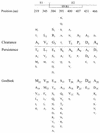Acute hepatitis C virus structural gene sequences as predictors of persistent viremia: hypervariable region 1 as a decoy
- PMID: 10074143
- PMCID: PMC104053
- DOI: 10.1128/JVI.73.4.2938-2946.1999
Acute hepatitis C virus structural gene sequences as predictors of persistent viremia: hypervariable region 1 as a decoy
Abstract
We hypothesized that hepatitis C virus (HCV) persistence is related to the sequence variability of putative envelope genes. This hypothesis was tested by characterizing quasispecies in specimens collected every six months from a cohort of acutely HCV-infected subjects (mean duration of specimen collection, 72 months after seroconversion). We evaluated 5 individuals who spontaneously cleared viremia and 10 individuals with persistent viremia by cloning 33 1-kb amplicons that spanned E1 and the 5' half of E2, including hypervariable region 1 (HVR1). To assess the quasispecies complexity and to detect variants for sequencing, the first PCR-positive sample was examined by using a previously described method that combines heteroduplex analysis and analysis of single-stranded conformational polymorphisms. The ratio of nonsynonymous to synonymous substitutions (dN/dS) within each sample was evaluated as an indicator of relative selective pressure. Amino acid sequences were analyzed for signature patterns, glycosylation signals, and charge. Quasispecies complexity was higher and E1 dN/dS ratios (selective pressure) were lower in those with persistent viremia; the association with persistence was strengthened by the presence of a combination of both characteristics. In contrast, a trend toward higher HVR1 dN/dS ratios was detected among those with persistent viremia. We did not detect any such association for factors that may affect complexity such as serum HCV RNA concentration. HVR1 had a lower positive charge in subjects with persistent viremia, although no consistent motifs were detected. Our data suggest that HCV persistence is associated with a complex quasispecies and immune response to HVR1.
Figures






Similar articles
-
Multigene tracking of quasispecies in viral persistence and clearance of hepatitis C virus.World J Gastroenterol. 2005 May 21;11(19):2874-84. doi: 10.3748/wjg.v11.i19.2874. World J Gastroenterol. 2005. PMID: 15902722 Free PMC article.
-
Evolutionary study of hepatitis C virus envelope genes during primary infection.Chin Med J (Engl). 2007 Dec 20;120(24):2174-80. Chin Med J (Engl). 2007. PMID: 18167197
-
Genetic evolution of structural region of hepatitis C virus in primary infection.World J Gastroenterol. 2002 Aug;8(4):686-93. doi: 10.3748/wjg.v8.i4.686. World J Gastroenterol. 2002. PMID: 12174379 Free PMC article.
-
[Genetic variation characteristics of the envelope region of hepatitis C virus in the patients with chronic hepatitis].Zhonghua Shi Yan He Lin Chuang Bing Du Xue Za Zhi. 2002 Sep;16(3):219-22. Zhonghua Shi Yan He Lin Chuang Bing Du Xue Za Zhi. 2002. PMID: 12665923 Chinese.
-
Genetic complexity of the hypervariable region 1 (HVR1) of hepatitis C virus (HCV): influence on the characteristics of the infection and responses to interferon alfa therapy in patients with chronic hepatitis C.J Med Virol. 1998 Apr;54(4):256-64. J Med Virol. 1998. PMID: 9557291
Cited by
-
Patterns of hepatitis C virus RNA levels during acute infection: the InC3 study.PLoS One. 2015 Apr 2;10(4):e0122232. doi: 10.1371/journal.pone.0122232. eCollection 2015. PLoS One. 2015. PMID: 25837807 Free PMC article.
-
Hepatitis C virus clearance, reinfection, and persistence, with insights from studies of injecting drug users: towards a vaccine.Lancet Infect Dis. 2012 May;12(5):408-14. doi: 10.1016/S1473-3099(12)70010-5. Lancet Infect Dis. 2012. PMID: 22541630 Free PMC article. Review.
-
Multigene tracking of quasispecies in viral persistence and clearance of hepatitis C virus.World J Gastroenterol. 2005 May 21;11(19):2874-84. doi: 10.3748/wjg.v11.i19.2874. World J Gastroenterol. 2005. PMID: 15902722 Free PMC article.
-
Managing occupational risks for hepatitis C transmission in the health care setting.Clin Microbiol Rev. 2003 Jul;16(3):546-68. doi: 10.1128/CMR.16.3.546-568.2003. Clin Microbiol Rev. 2003. PMID: 12857782 Free PMC article. Review.
-
Dynamic coinfection with multiple viral subtypes in acute hepatitis C.J Infect Dis. 2010 Dec 15;202(12):1770-9. doi: 10.1086/657317. Epub 2010 Nov 10. J Infect Dis. 2010. PMID: 21067369 Free PMC article.
References
-
- Abe K, Inchauspe G, Fujisawa K. Genomic characterization and mutation rate of hepatitis C virus isolated from a patient who contracted hepatitis during an epidemic of non-A, non-B hepatitis in Japan. J Gen Virol. 1992;73:2725–2729. - PubMed
-
- Alter M J, Margolis H S, Krawczynski K, Judson F N, Mares A, Alexander W J, Hu P Y, Miller J K, Gerber M A, Sampliner R E, Meeks E, Beach M J. The natural history of community acquired hepatitis C in the United States. N Engl J Med. 1992;327:1899–1905. - PubMed
-
- Anonymous. Hepatitis C: global prevalence. Weekly Epidemiol Rec. 1997;72:341–348. - PubMed
Publication types
MeSH terms
Substances
Associated data
- Actions
- Actions
- Actions
- Actions
- Actions
- Actions
- Actions
- Actions
- Actions
- Actions
- Actions
- Actions
- Actions
- Actions
- Actions
- Actions
- Actions
- Actions
- Actions
- Actions
- Actions
- Actions
- Actions
- Actions
- Actions
- Actions
- Actions
- Actions
- Actions
- Actions
Grants and funding
LinkOut - more resources
Full Text Sources
Medical
Molecular Biology Databases

